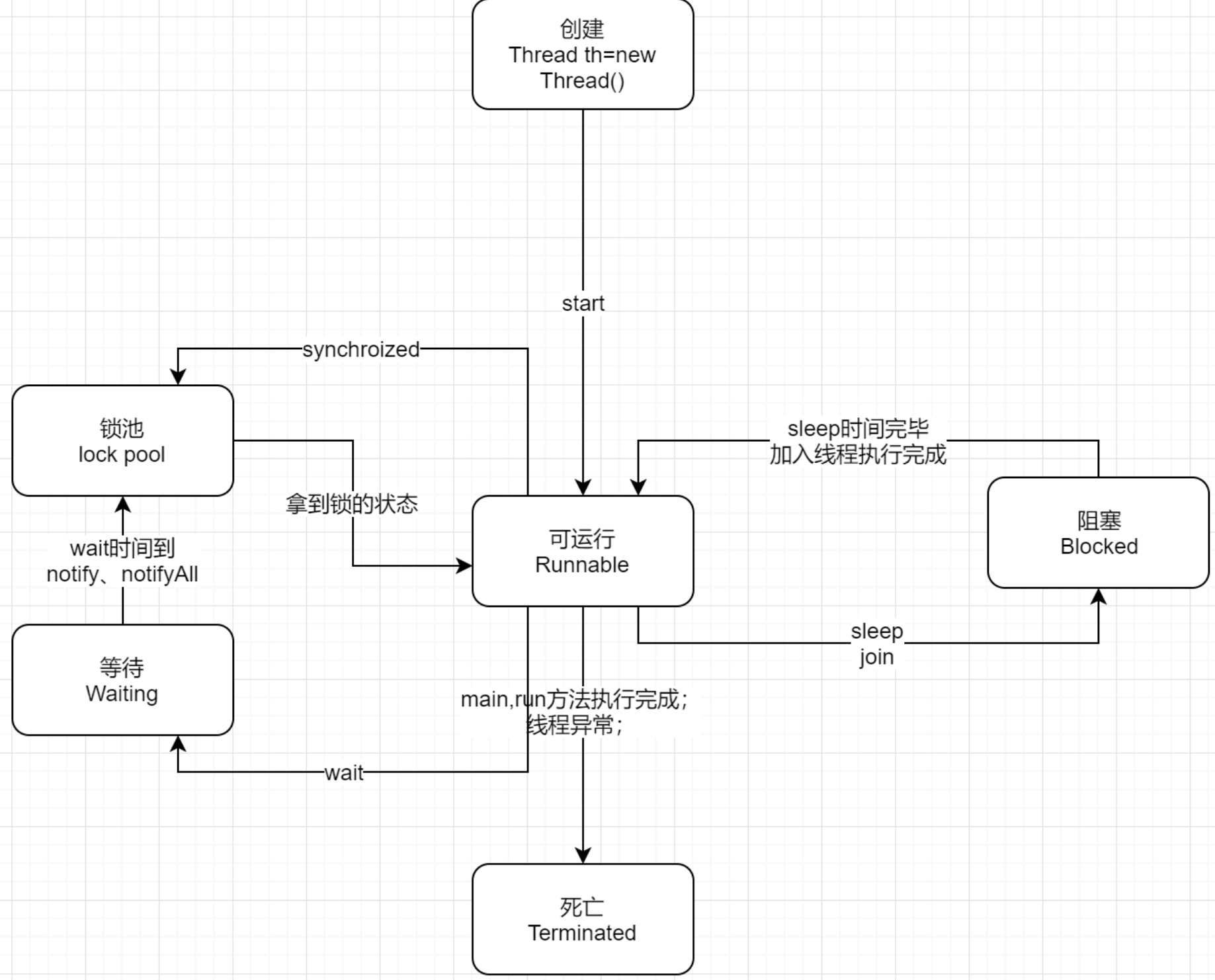一文看尽Java-Thread
一、前言
主要分成两部说起:Thread源码解读和常见面试题解答,废话不多说开始;
二、源码解读
首先看下构造函数,构造函数都是通过调用init方法对属性进行初始化,主要是对线程组、线程名字、栈大小等信息进行初始化;init内部通过调用currentThread本地方法,获取当前的线程,这个本地方法封装在JVM中,有兴趣的可以看下这个这个链接查找下JVM实现https://hg.openjdk.java.net/jdk8u,接下来对ThreadGroup的判断,如果没有传入线程组的话, 第一是使用SecurityManager中的ThreadGroup, 如果从SecurityManager 中获取不到ThreadGroup(), 那么就从当前线程中获取线程组,最后做了检验和些参数的赋值,整体上相对比较简单;
private void init(ThreadGroup g, Runnable target, String name,
long stackSize) {
init(g, target, name, stackSize, null);
}
private void init(ThreadGroup g, Runnable target, String name,
long stackSize, AccessControlContext acc) {
if (name == null) {
throw new NullPointerException("name cannot be null");
}
this.name = name.toCharArray();
Thread parent = currentThread();
SecurityManager security = System.getSecurityManager();
if (g == null) {
/* Determine if it's an applet or not */
/* If there is a security manager, ask the security manager
what to do. */
if (security != null) {
g = security.getThreadGroup();
}
/* If the security doesn't have a strong opinion of the matter
use the parent thread group. */
if (g == null) {
g = parent.getThreadGroup();
}
}
/* checkAccess regardless of whether or not threadgroup is
explicitly passed in. */
g.checkAccess();
/*
* Do we have the required permissions?
*/
if (security != null) {
if (isCCLOverridden(getClass())) {
security.checkPermission(SUBCLASS_IMPLEMENTATION_PERMISSION);
}
}
g.addUnstarted();
this.group = g;
this.daemon = parent.isDaemon();
this.priority = parent.getPriority();
if (security == null || isCCLOverridden(parent.getClass()))
this.contextClassLoader = parent.getContextClassLoader();
else
this.contextClassLoader = parent.contextClassLoader;
this.inheritedAccessControlContext =
acc != null ? acc : AccessController.getContext();
this.target = target;
setPriority(priority);
if (parent.inheritableThreadLocals != null)
this.inheritableThreadLocals =
ThreadLocal.createInheritedMap(parent.inheritableThreadLocals);
/* Stash the specified stack size in case the VM cares */
this.stackSize = stackSize;
/* Set thread ID */
tid = nextThreadID();
}
public Thread() {
init(null, null, "Thread-" + nextThreadNum(), 0);
} public Thread(Runnable target) {
init(null, target, "Thread-" + nextThreadNum(), 0);
}
Thread(Runnable target, AccessControlContext acc) {
init(null, target, "Thread-" + nextThreadNum(), 0, acc);
}
// 线程名
public Thread(String name) {
init(null, null, name, 0);
}
//线程组和线程名
public Thread(ThreadGroup group, String name) {
init(group, null, name, 0);
}
//线程任务,线程名
public Thread(Runnable target, String name){
init(null, target, name, 0);
}
// 线程组, 线程任务, 线程名 ,栈大小
public Thread(ThreadGroup group, Runnable target, String name, long stackSize) {
init(group, target, name, stackSize);
}
接下来看下主要的属性:
// 类加载的时候,调用本地的注册本地方静态方法, 这个方法是本地方法
private static native void registerNatives();
static {
registerNatives();
}
private volatile char name[];
private int priority;
private Thread threadQ;
private long eetop;
/* Whether or not to single_step this thread. */
private boolean single_step;
/* Whether or not the thread is a daemon thread. */
// 设设置这个线程是否是守护线程
private boolean daemon = false;
/* JVM state */
private boolean stillborn = false;
/* What will be run. */
// 要执行的run方法的对象
private Runnable target;
/* The group of this thread */
// 这个线程的线程组
private ThreadGroup group;
/* The context ClassLoader for this thread */
// 这个线程的上下文类加载器
private ClassLoader contextClassLoader;
/* The inherited AccessControlContext of this thread */
private AccessControlContext inheritedAccessControlContext;
/* For autonumbering anonymous threads. */
private static int threadInitNumber;
private static synchronized int nextThreadNum() {
return threadInitNumber++;
}
/* ThreadLocal values pertaining to this thread. This map is maintained
* by the ThreadLocal class. */
ThreadLocal.ThreadLocalMap threadLocals = null;
/*
* InheritableThreadLocal values pertaining to this thread. This map is
* maintained by the InheritableThreadLocal class.
*/
ThreadLocal.ThreadLocalMap inheritableThreadLocals = null;
/*
* The requested stack size for this thread, or 0 if the creator did
* not specify a stack size. It is up to the VM to do whatever it
* likes with this number; some VMs will ignore it.
*/
// 给这个线程设置的栈的大小,默认为0
private long stackSize;
/*
* JVM-private state that persists after native thread termination.
*/
private long nativeParkEventPointer;
/*
* Thread ID
*/ //线程id
private long tid;
/* For generating thread ID */
private static long threadSeqNumber;
/* Java thread status for tools,
* initialized to indicate thread 'not yet started'
*/
private volatile int threadStatus = 0;
private static synchronized long nextThreadID() {
return ++threadSeqNumber;
}
/**
* The argument supplied to the current call to
* java.util.concurrent.locks.LockSupport.park.
* Set by (private) java.util.concurrent.locks.LockSupport.setBlocker
* Accessed using java.util.concurrent.locks.LockSupport.getBlocker
*/
volatile Object parkBlocker;
/* The object in which this thread is blocked in an interruptible I/O
* operation, if any. The blocker's interrupt method should be invoked
* after setting this thread's interrupt status.
*/
private volatile Interruptible blocker;
private final Object blockerLock = new Object();
/* Set the blocker field; invoked via sun.misc.SharedSecrets from java.nio code
*/
void blockedOn(Interruptible b) {
synchronized (blockerLock) {
blocker = b;
}
}
/**
* The minimum priority that a thread can have.
*/
// 线程执行的最低优先级 为1
public final static int MIN_PRIORITY = 1;
/**
* The default priority that is assigned to a thread.
*/
// 线程默认的执行优先级为 5
public final static int NORM_PRIORITY = 5;
/**
* The maximum priority that a thread can have.
*/
// 线程执行的最高的优先级为 10
public final static int MAX_PRIORITY = 10;
最后介绍下方法的作用和线程状态,源码都比较简单,没必进行过多的介绍,都是通过调用JVM的本地方法实现;

线程状态:

三、常见面试题
1.线程与进程的区别?
进程是资源分配最小的单位,线程是CPU调度最小的单位;
线程属于进程,共享进程分配的资源;
进程属于抢占式调度,资源不相互共享;
2.start和run的区别?
run是Thread的一个普通的方法;
start方法会创建一个新的子线程并启动;
3.sleep与wait的区别?
sleep是Thread方法,wait是Object的方法;
wait方法只能在synchroized方法或者块中使用;
Thread.sleep只会让出CPU,不会改变锁的行为;
Object.wait不仅会让出CPU,同时还会释放占有同步资源的锁;
4.线程状态的转化?
图中将WAITING 和TIMED_WAITING 两个状态合并为WAITING ,没有分开,大家不要搞错;

5.如何处理线程的返回值?
主线程等待法,使用while等待主线程返回值;
join阻塞当前线程以等待子线程;
通过FuTureTask获取子线程的返回值;
public class MyCallable implements Callable<String> {
@Override
public String call() throws Exception {
String value="test";
System.out.println("start");
Thread.sleep(5000);
System.out.println("end");
return value;
}
}
public class FutureTaskDemo {
public static void main(String[] main) throws ExecutionException, InterruptedException {
FutureTask<String> futureTask=new FutureTask<String>(new MyCallable());
new Thread(futureTask).start();
if (!futureTask.isDone()){
System.out.println("waiting");
}
System.out.println("return"+futureTask.get());
}
}
通过线程池获取返回值;
public class ThreadPoolDemo {
public static void main(String[] args){
ExecutorService executorService= Executors.newCachedThreadPool();
Future<String> futureTask=executorService.submit(new MyCallable());
if (!futureTask.isDone()){
System.out.println("wait");
}
try {
System.out.println(futureTask.get());
}catch (InterruptedException ex){
ex.printStackTrace();
}catch (ExecutionException ex){
ex.printStackTrace();
}finally {
executorService.shutdown();
}
}
}
6.Thread和Runnable?
Thread是类,Runnable是接口,Thread是Runnable实现;
类的继承单一原则,Runnable是更高层次的抽象;
四、结束
欢迎大家加群438836709!欢迎大家关注我!

最新文章
- 通过url传参
- css3 缓动公式
- oracle游标透彻详解分析
- memset 的实现分析
- C++ code Summary --- 2015.11.8
- 关于Google Chorme中字体小于12px的问题
- DEDECMS中,list标签和pagelist标签
- ios6如何处理内存,分别为前警告后
- 应用程序的关闭退出(在FMX中,Activity替代了Form的概念)
- 【Android基础】Activity之间进行参数传递的三种方式
- string的数值转换
- SSL 双向认证
- ubuntu 虚拟机上的 django 服务,在外部Windows系统上无法访问
- Python 操作集合
- jsp相关笔记(一)
- linux 分区、目录及用途
- OWA (Office Web Access)
- lua 函数基础
- express form/ajax 后端获取前端数据
- Maven 逆向工程